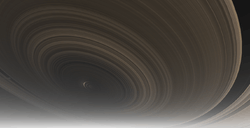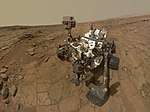Kepler-35
Kepler-35 is a binary star system in the constellation of Cygnus. These stars, called Kepler-35A and Kepler-35B have masses of 89% and 81% solar masses respectively, and both are assumed to be of spectral class G. They are separated by 0.176 AU, and complete an eccentric orbit around a common center of mass every 20.73 days.[4]
| Observation data Epoch J2000 Equinox J2000 | |
|---|---|
| Constellation | Cygnus |
| Right ascension | 19h 37m 59.2726s[1] |
| Declination | +46° 41′ 22.952″[1] |
| Characteristics | |
| Spectral type | G / G[2] |
| Variable type | Algol[3] |
| Astrometry | |
| Proper motion (μ) | RA: −2.279±0.058[1] mas/yr Dec.: −8.262±0.070[1] mas/yr |
| Parallax (π) | 0.5215 ± 0.0336[1] mas |
| Distance | 6,300 ± 400 ly (1,900 ± 100 pc) |
| Orbit[3] | |
| Period (P) | 20.73 d |
| Semi-major axis (a) | 0.176 au |
| Eccentricity (e) | 0.16 |
| Inclination (i) | 89.44° |
| Details[4] | |
| Kepler-35A | |
| Mass | 0.8877 M☉ |
| Radius | 1.0284 R☉ |
| Luminosity | 0.94 L☉ |
| Surface gravity (log g) | 4.3623 cgs |
| Temperature | 5,606 K |
| Metallicity | -0.13 |
| Kepler-35B | |
| Mass | 0.8094 M☉ |
| Radius | 0.7861 R☉ |
| Luminosity | 0.41 L☉ |
| Surface gravity (log g) | 4.5556 cgs |
| Temperature | 5,202 K |
| Metallicity | -0.13 |
| Age | 8-12 Myr |
| Other designations | |
| Database references | |
| SIMBAD | data |
| KIC | data |
Description
The Kepler-35 system consists of two stars slightly less massive than the sun in a 21-day orbit aligned edge-on to us so that the stars eclipse each other. The orbit has a semi-major axis 0.2 au and a mild eccentricity of 0.16. of The precise measurements made by the Kepler satellite allow doppler beaming to be detected, as well as brightness variations due to the ellipsoidal shape of the stars and reflections of one star on the other.[4]
The primary star has a mass of 0.9 M☉ and a radius fractionally larger than the sun. With an effective temperature of 5,606 K, its luminosity is 0.94 L☉. The secondary star has a mass of 0.8 M☉, a radius of 0.8 R☉, an effective surface temperature of 5,202 K, and a bolometric luminosity of 0.4 L☉.[4]
Planetary system
Kepler-35b is a gas giant that orbits the two stars in the Kepler-35 system. The planet is over an eighth of Jupiter's mass and has a radius of 0.728 Jupiter radii. The planet completes a somewhat eccentric orbit every 131.458 days from a semimajor axis of just over 0.6 AU, only about 3.5 times the semi-major axis between the parent stars. The proximity and eccentricity of the binary star as well as both stars have similar masses results the planet's orbit to significantly deviate from Keplerian orbit.[5] Studies have suggested that this planet must have been formed outside its current orbit and migrated inwards later.[6]
| Companion (in order from star) |
Mass | Semimajor axis (AU) |
Orbital period (days) |
Eccentricity | Inclination | Radius |
|---|---|---|---|---|---|---|
| b | 0.127 MJ | 0.60347 | 131.458 | 0.042 | 90.760° | 0.728 RJ |
References
- Brown, A. G. A.; et al. (Gaia collaboration) (August 2018). "Gaia Data Release 2: Summary of the contents and survey properties". Astronomy & Astrophysics. 616. A1. arXiv:1804.09365. Bibcode:2018A&A...616A...1G. doi:10.1051/0004-6361/201833051. Gaia DR2 record for this source at VizieR.
- Jean Schneider (2012). "Notes for star Kepler-35(AB)". Extrasolar Planets Encyclopaedia. Retrieved 7 April 2012.
- . Bibcode:2011AJ....141...78C. Cite journal requires
|journal=(help); Missing or empty|title=(help) - Welsh, William F.; et al. (2012). "Transiting circumbinary planets Kepler-34 b and Kepler-35 b". Nature. 481 (7382): 475–479. arXiv:1204.3955. Bibcode:2012Natur.481..475W. doi:10.1038/nature10768. PMID 22237021.
- Leung, Gene C. K.; Hoi Lee, Man (2013). "AN ANALYTIC THEORY FOR THE ORBITS OF CIRCUMBINARY PLANETS". The Astrophysical Journal. 763: 107. doi:10.1088/0004-637X/763/2/107.
- Paardekooper, Sijme-Jan; Leinhardt, Zoë M.; Thébault, Philippe; Baruteau, Clément (2012). "HOW NOT TO BUILD TATOOINE: THE DIFFICULTY OF IN SITU FORMATION OF CIRCUMBINARY PLANETS KEPLER 16b, KEPLER 34b, AND KEPLER 35b". The Astrophysical Journal. 754: L16. arXiv:1206.3484. doi:10.1088/2041-8205/754/1/L16.
Further reading
. Bibcode:2018AstL...44..119D. Cite journal requires |journal= (help); Missing or empty |title= (help)


